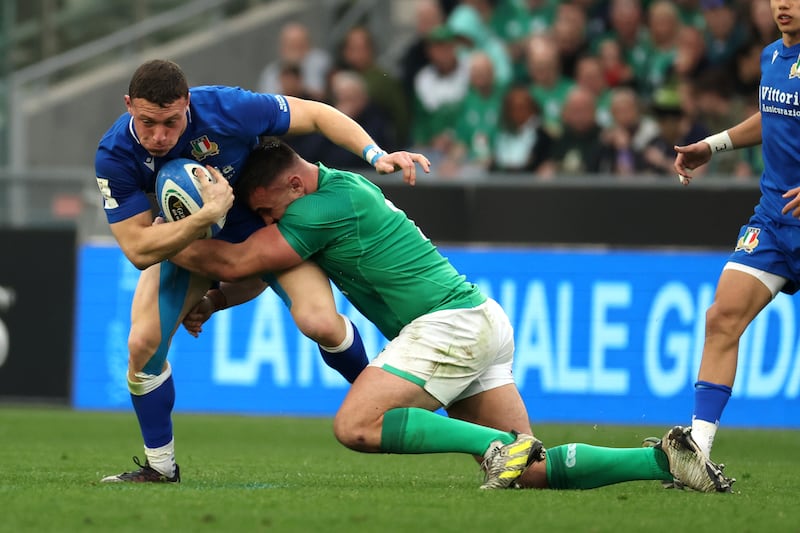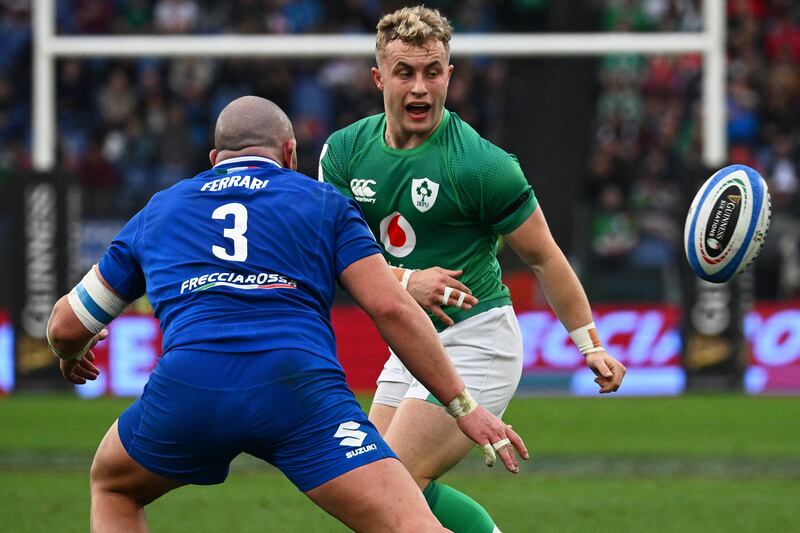Watching from a lofty perch alongside my ITV colleagues Miles Harrison and David Flatman at the Stadio Olimpico, it offered an excellent panoramic view to observe the general movement of Italy and Ireland, how they attacked and defended, and it also provided an insight into what the teams were trying to do to manipulate the opposition.
It was a rip-roaring contest, one of thrills and spills that entertained from first to last whistle. Initially ignoring the gentle ribbing I received from my television colleagues who enthusiastically pushed Italy’s credentials to cause an upset, we were quickly engrossed in the end-to-end spectacle.
The home side clung doggedly to Ireland’s coat-tails and with one better decision might have even drawn level on the scoreboard in the second half. They matched Ireland in many of the key metrics including their breakdown work with 0-3 second Italian rucks running at over 60 per cent.
Italy attacked well off the set piece, ran with purpose and precision, and allowed the ball to do the work in getting it to the edges quickly. The skill sets were impressive and the only thing lacking was composure under pressure that surfaced from time to time. Italy fluffed their lines at key times just when it looked like they were about to rein in a stuttering Ireland team.
The one moment on which Italian hopes of victory ran aground was the decision by centre Juan Ignacio Brex to plump for a cross-field kick rather than pushing the ball to a wider channel where a three-on-two was on offer. It wasn’t a guaranteed try but it had better prospects than a lobbed crosskick.
Ireland led 27-20 at that stage and who knows what those final minutes would have contained if the home side had managed to grab a try. Yet it was still a performance to be proud of from the Italians, brave in their adventure, the main stumbling block to their hopes of winning an inability to be clinical in finishing off opportunities created; some of that is mental, some physical.
Italy are moving in the right direction through an academy system that prioritises coach and player development, with a strong concentration on fundamental skills. Stephen Aboud was the primary architect. It highlights the benefits of giving 11- and 12-year-olds the right tools to play the game.
The average age of the senior squad is 26, a figure that matches the French focus on bringing through players at a younger age. Ange Capuozzo, Paolo Garbisi and the Cannone brothers, Niccolò and Lorenzo, provide some of the stardust to complement some of the older heads under the umbrella coaching of the excellent Kieran Crowley.

Sadly, the quantum leap in player quality we witnessed at the weekend may become a generational anomaly as the Italian federation is in the process of changing this extremely successful pathway in favour of another.
It is also a gentle reminder of the vulnerability or perhaps risk that we have within our own system, with 19 of the 23 players on duty at the Stadio Olimpico coming through the schools’ pathway, four from overseas but not one player that has come through the club system.
What we saw at the weekend was a fair reflection of the strength in depth of our extended squad, one that came to light because of a significant injury list
Imagine if we applied the long-term thinking that the Italians did and how it could facilitate a move to more progressive multi-dimensional pathways that would not only increase numbers but give young people the skill sets to enjoy the game at whatever level they played.
That template might address some of the shortcomings within Irish rugby structures, which have seen a boom-and-bust cycle since the introduction of professionalism in 1995.
It’s been a rollercoaster ride from beating the world champions in their backyard in 2004 to the chaotic unwinding of Irish hopes at the 2007 World Cup, from the Grand Slam (2009) to losing to Italy (2013), from back-to-back Six Nations champions (2014, 2015) to the implosion of the 2019 World Cup in Japan.
That is not to say Andy Farrell’s era will end in a cloud of smoke, quite the opposite I believe, but it will have a peak, then plateau before concluding, naturally or enforced. The two fundamental parts of any successful sporting equation for me are the relationship between the coaches and the players, and the quality of the underlying players.
What we saw at the weekend was a fair reflection of the strength in depth of our extended squad, one that came to light because of a significant injury list. The performance reflected fairly as Ireland looked like a team missing some key players.
Every team has them, those that possess the talent to consistently and positively influence the outcome of matches. I wrote in 2015 that had New Zealand lost the players Ireland did in the final group match, would they have won that World Cup? Highly unlikely.
We are still reliant on some key players but what is different this time round is the coaching environment and the way the players are thriving within it. Ireland would possibly have lost that match had the balance in that environment been a little off.
Garbisi was a key player for Italy on his return to the team and you could see the way his team-mates responded to his presence on the pitch. He dictated the tempo, initially trying to kick his team into positions to try to gain territory and put pressure on the Irish. But he found a worthy adversary in that respect in Hugo Keenan, who was once again excellent.
I’m struggling to remember a time when the ball found grass before Keenan arrived. His incredible backfield coverage frustrated the French two weeks ago and at the weekend forced the Italians into playing a bit more rather than kicking. The opening return by Keenan should have resulted in a try for James Lowe.
I don’t necessarily feel Italy went after Bundee Aki in the 13 channel, more that they wanted to attack Ireland in those wider spaces. Ireland’s laboured lateral movement in the midfield reinforced how important Garry Ringrose is in that position.
[ Six Nations: Finlay Bealham ruled out for the rest of the tournament with injuryOpens in new window ]
The Italians were fluent in their attacking patterns in putting Brex and Tommaso Menoncello as first receivers with Garbisi and Capuozzo sweeping late and deep into the channels to great effect. The defensive role of the outside centre is a keystone in connecting those inside and outside in terms of alignment.
While moments like Ringrose shooting out of the line to clobber Dan Biggar killed Welsh momentum stone dead, there are many other micro-moments in a match where the ability to read the opposition and know what’s required is crucial. It was clear that there was something missing in this regard in Rome for about 60 minutes. Jimmy O’Brien’s arrival added a sense of calm and a better shape defensively.
While Italy matched Ireland in the ambition to play rugby, they lacked that clinical edge at crucial times. Farrell had a trump card to play in that final quarter, the quality of the bench. The impact of Ryan Baird, Conor Murray and O’Brien was immense.
Murray, who looks rejuvenated in recent games, possessed the big-match savvy to manage affairs in the way Ireland required. He knew exactly where and how he could influence the game.
The tempo of Ireland’s attack increased with Murray focusing on the fringes of rucks where tired Italian defenders had not been properly challenged all day. He varied the point of attack, a fact that was perfectly illustrated in the build-up to Mack Hansen’s first try.

Such was his impact, it is only fair to wonder why Craig Casey had not managed to influence play a little more before he was withdrawn. Ireland had their fair share of quick rucks, and while they scored five tries and created several other chances for periods, they looked far too predictable, and this responsibility falls on the halfbacks.
I think Casey has yet to establish himself at this level, his speed to ruck is unquestionable but his decision-making or his threat around the breakdown had minimal impact on the Italian defence. The inside pass to Hansen showed what he is capable of, but it was a game that passed him by for the most part.
The biggest momentum swing in terms of player impact was when Caelan Doris switched back to number eight. He was more involved in Ireland’s broken-field attack, applying footwork and an unpredictability that had been missing for large parts of the game.
There are many things that Farrell and co will learn from Rome, but one is that Doris is too valuable a player to be moved to that less-familiar blindside role. Peter O’Mahony freed up the Mayo man to Ireland’s immediate benefit.
The way Ireland have been creating and embracing a “bit of adversity” for themselves, I think this match will be exactly what Farrell will have secretly wanted. The thing about adversity is that it will require a response, and with two weeks to go until the game against Scotland you can be sure that plenty of people have been sent away with a little or a lot to think about.
Scotland showed that they will not be found wanting in Edinburgh, with an attacking display that will be further honed for the visiting Irish. The next match becomes your toughest one and this will certainly be the case.

















